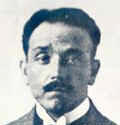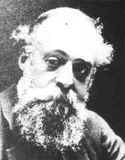| GAUDÍ - The Man | Biographic Synthesis Extended Biography Chronology Influences Gaudí's Political and Patriotic Sentiment Gaudí's Friends Gaudí's Collaborators |
| The Work | Architectonic Work Characteristic Styles Technical Aspects Decorative Aspects - Ceramics | Furniture | Iron and Other Metals | Stained Glasses |
| Sources and Other Information | Links & Bibliography |
Gaudí’s Friends:
Gaudí’s social life never was very active; he was more of a solitary soul. Nevertheless, this is only partly true. He was able to maintain relatioCount of Güell Portraitnships with many personalities he met in his professional life with whom he shared very similar ideological beliefs—such as, for instance, distinguished representatives of the Catholic Church like Cardinal Vidal i Barraquer, who helped him in his constant struggle to ensure the continuation of the construction of the Sagrada Família, or various childhood friends like Eduard Toda i Güell and Josep Ribera i Sans, who were his companions both at school and on his first excursions into the study of cultural aspects related principally to Catalan history.
He also had meaningful relationships with some of his collaborators, like the sculptors Carles Maní—whom Gaudí helped as much as he could with his constant economic difficulties—and the Matamalas (father and son). Despite his harsh disposition, Gaudí treated his workers with consideration and respect, especially those at the Sagrada Família. Most of the people referenced in this section are also mentioned below in “Gaudí’s Collaborators,” since most of his friends were people who knew him for work-related reasons.
In 1878, Gaudí met the Count of Güell, Eusebi Güell i Bacigalupi, whose friendship would be essential both in his personal life and in his professional development. Güell was married to a daughter of Antoni López, the Marqués de Comillas, and was therefore part of the most powerful family in Catalunya, which carried with it great prestige and influence in the industrial and artistic circles of Barcelona at that time. The friendship between the two was very close (see the portrait of Count Güell at right). Gaudí built a considerable part of his oeuvre for this family: the Palau Güell, the Crypt of the Colònia Güell and Park Güell, the Güell Pavilions, the Güell Cellar in Garraf, and many others.
This relationship with Eusebi Güell was the source of other contacts with significant personages in Catalan culture. From it came his relationship with Jacint Verdaguer, the poet and Güell family priest. Güell greatly admired Verdaguer and his work, and Gaudí shared the count’s sentiment. From 1880-1890, all three men had frequent opportunities to discuss religion, Catalunya, architecture, and the intersection of the three.
Verdaguer obviously influenced Gaudí, especially via his epic poem l’Atlantida (Atlantis), the premier Catalanist work of the era, which Gaudí “illustrated” in stone and metal in the garden of the Hesperides on the grounds of the Güell Pavilions for the count’s horses. Naturally, within such a religious orbit, in addition to the aforementioned Cardinal Vidal i Barraquer, Gaudí also knew important religious figures like Bishop Torres i Bages. Also noteworthy are Joan Baptista Grau i Villespinós, Bishop of Astorga, who put him in charge of that town’s Episcopal Palace; and Bishop Campins of Ciutat de Mallorca, who put him in charge of the restoration of the cathedral.
The patriotic idealism that began to manifest itself in Gaudí’s visits to Poblet with Eduard Toda and Josep Ribera culminated in 1886 with his membership in the Associació Catalanista d’Excursions Scientífiques, which promoted interest in nature and architecture from not only a Catalan, but also profoundly Catalanista, perspective. Gaudí’s interest in these subjects was so great that he was soon chosen to be part of the governing committee and oversee architectural patrimony. His involvement with the Associació allowed him to establish relationships with people such as writer Ángel Guimerà, painter Dionis Baixeras, and sculptor Pau Gargallo. One of his companions as a student was Salvador Pagès i Anglada, who later would become the motivating force behind the Sociedad Cooperativa Obrera Mataronense, a textile workers’ cooperative based on utopian principles of egalitarian collaboration among workers, artisans, and patrons—principles with which Gaudí sympathized. Gaudí completed various projects for the Cooperative—some architectural, others logos for business marketingJujol Portrait designs—on which he collaborated with his friend Emili Cabanyes. It was there he met the only woman with whom it is known he tried to have a romantic relationship: Pepeta Moreu. His work at the cooperative symbolized a period of intense collaboration with Salvador Pagès; since Gaudí had to make many trips to Mataró, he had the chance to discuss at length his social ideas with Pagès. Gaudí and Pagès were also members of the Barcelona Atheneum, an important Catalanist center and meeting place for illustrious citizens.

Gaudí was very close to other collaborators like Francesc Berenguer, whom he knew from childhood, and Josep Maria Jujol. The three felt a decided mutual affection that would be fundamentally important to the construction of the Güell Cellar in Garraf (with Berenguer) and the Park Güell and Casa Batlló (with Jujol).
Gaudí was very close to Father Gil Parés i Vilasau, the first to preside over Mass in the Sagrada Família crypt, and with his brother, Ramon. After Gaudí’s death, both profoundly religious brothers fell victims to the religious persecution that enveloped the city at the beginning of the Spanish Civil War (1936-1939); both were assassinated.

